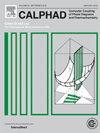Ternary compounds and phase equilibria at 320 °C of the Mg–Zn–La system in the region below 50 at%La
IF 1.9
3区 材料科学
Q4 CHEMISTRY, PHYSICAL
Calphad-computer Coupling of Phase Diagrams and Thermochemistry
Pub Date : 2025-04-26
DOI:10.1016/j.calphad.2025.102832
引用次数: 0
Abstract
Accurate phase diagrams are indispensable to boost the development of novel magnesium alloys. Up to now, however, there are still tremendous uncertainties about the number of the stable ternary compounds and related phase relationships in the Mg–Zn–La system. The Mg–Zn–La phase diagram at 320 °C in the region of <50 at% La was investigated by using 45 equilibrated alloys. Ten ternary compounds (labeled as τ1 to τ10) were found and their homogeneity ranges were measured. Two of the ternary compounds, i.e. τ1 (space group Cmc21) and τ8 (space group Immm), are identified to be the reported τ1-La(Mg,Zn)11 and La3(Mg,Zn)11 in literature, respectively. The remaining eight ternary compounds (τ2 to τ7, τ9 and τ10) are newly found in the present work. The lattice parameters for five of the ternary compounds (τ1 to τ3, τ6 and τ8) were calculated with the Jade 6.5 software, based on the XRD patterns. The LaMg2 phase was found at 320 °C and could be tentatively considered as a stabilized ternary phase with the third elements. Both the τ9 and τ10, which are in phase equilibrium with the (Mg) matrix and very close to the Mg-Zn side, are expected to act as important strengthening phases in the Mg-Zn based alloys.
Mg-Zn-La体系在320°C时的三元化合物及其在50%以下的相平衡
准确的相图对于促进新型镁合金的发展是必不可少的。然而,到目前为止,对于Mg-Zn-La体系中稳定三元化合物的数量及其相关系仍存在很大的不确定性。采用45种平衡合金,研究了在320°C <;50 at% La区域的Mg-Zn-La相图。发现了10个标记为τ1 ~ τ10的三元化合物,并测定了它们的均匀性范围。其中两个三元化合物τ1(空间群Cmc21)和τ8(空间群Immm)分别为文献报道的τ1- la (Mg,Zn)11和La3(Mg,Zn)11。其余8个三元化合物(τ2 ~ τ7, τ9和τ10)是本文新发现的。根据XRD谱图,用Jade 6.5软件计算了5个三元化合物(τ1 ~ τ3, τ6和τ8)的晶格参数。在320°C时发现了LaMg2相,可以暂时认为它是与第三元素稳定的三元相。τ9和τ10与(Mg)基体处于相平衡状态,且非常靠近Mg- zn侧,可望成为Mg- zn基合金中重要的强化相。
本文章由计算机程序翻译,如有差异,请以英文原文为准。
求助全文
约1分钟内获得全文
求助全文
来源期刊
CiteScore
4.00
自引率
16.70%
发文量
94
审稿时长
2.5 months
期刊介绍:
The design of industrial processes requires reliable thermodynamic data. CALPHAD (Computer Coupling of Phase Diagrams and Thermochemistry) aims to promote computational thermodynamics through development of models to represent thermodynamic properties for various phases which permit prediction of properties of multicomponent systems from those of binary and ternary subsystems, critical assessment of data and their incorporation into self-consistent databases, development of software to optimize and derive thermodynamic parameters and the development and use of databanks for calculations to improve understanding of various industrial and technological processes. This work is disseminated through the CALPHAD journal and its annual conference.

 求助内容:
求助内容: 应助结果提醒方式:
应助结果提醒方式:


